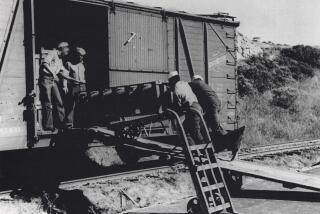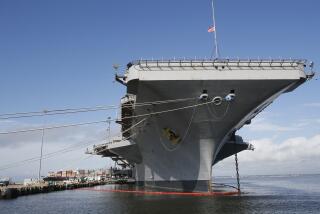Panel Doubts Navy Probe of Iowa Blast : Tragedy: A House panel said the Navy failed to prove a seaman caused an explosion aboard the battleship Iowa that killed 47 men.
- Share via
WASHINGTON — A House panel concluded today that the Navy failed to prove its claim that gunner’s mate Clayton Hartwig most likely caused the “wrongful, intentional” explosion in one of the battleship Iowa’s 16-inch guns that killed 47 sailors last April.
Hartwig and 46 shipmates died in the explosion that was graphically recorded on videotape from outside the No. 2 gun turret. Protests from his family led to congressional hearings and the report from the investigations subcommittee of the House Armed Services Committee.
“By the standards of the U.S. justice system, the subcommittee does not believe that Clayton Hartwig could be convicted of any crime. By the more subjective standards of history, there will always be a case to be made against him.
“By the standards of this subcommittee--and the standards we think should have been applied in the Navy’s investigation--there is only a hypothesis, and a tenuous one at that,” the panel’s report said.
Rep. Nicholas Mavroules (D-Mass.), the subcommittee’s chairman, said, “After careful review of the Navy’s investigation, I honestly believe that the Navy failed to substantiate beyond reasonable doubt its conclusions that . . . Hartwig generated the tragic explosion.”
Mavroules was sharply critical of the Navy for its handling of the case, saying, “The only thing more tragic than the deaths of the 47 young seamen last April was the Navy’s failure to conduct a proper investigation of the event.
“In my judgment, there is something inherently wrong with an organization investigating itself,” he said, suggesting the need for “the establishment of an outside, independent investigative body for the military services.”
The full committee’s chairman, Rep. Les Aspin (D-Wis.), said the case “points out the inherent evils in any organization investigating itself.”
The Navy investigation “fell into the trap of an excess of certitude,” Aspin said. “Thin gruel became red meat.”
At the Pentagon, the Navy said it stood by its report.
On Sept. 7, the Navy said a nearly five-month investigation had concluded that the fiery April 19, 1989, blast was caused “by a wrongful, intentional act, most probably the insertion of a detonating device between powder bags 1 and 2” and that the “most likely” suspect was the 24-year-old Hartwig.
One theory for the blast, which came during a firing exercise, was that Hartwig was despondent over the souring of a relationship with Kendall Truitt, a member of the Iowa crew.
Hartwig had named Truitt as beneficiary of his life insurance, but Truitt denied any role in the blast, insisted that he had never been anything other than a friend to Hartwig and said the Navy was looking for a scapegoat.
More to Read
Sign up for Essential California
The most important California stories and recommendations in your inbox every morning.
You may occasionally receive promotional content from the Los Angeles Times.













